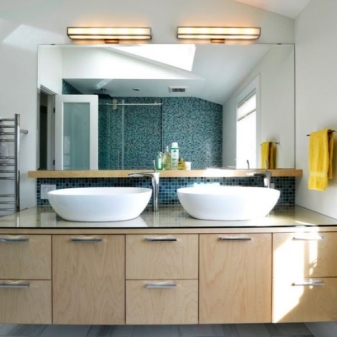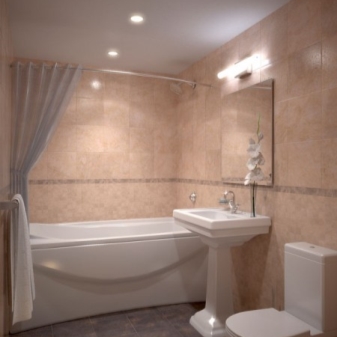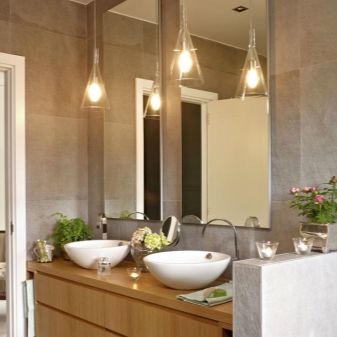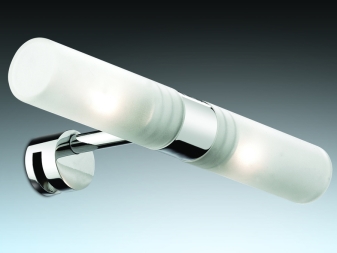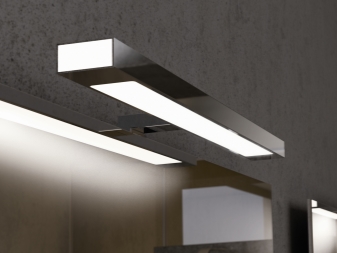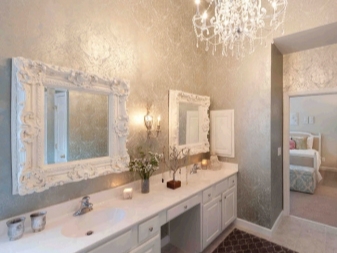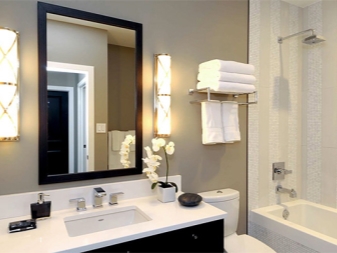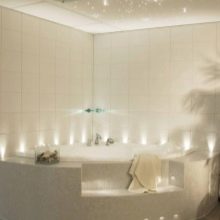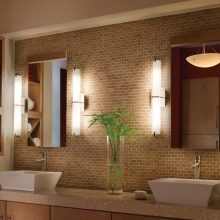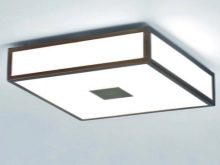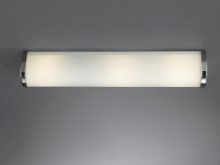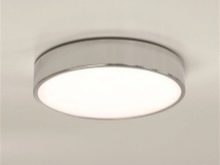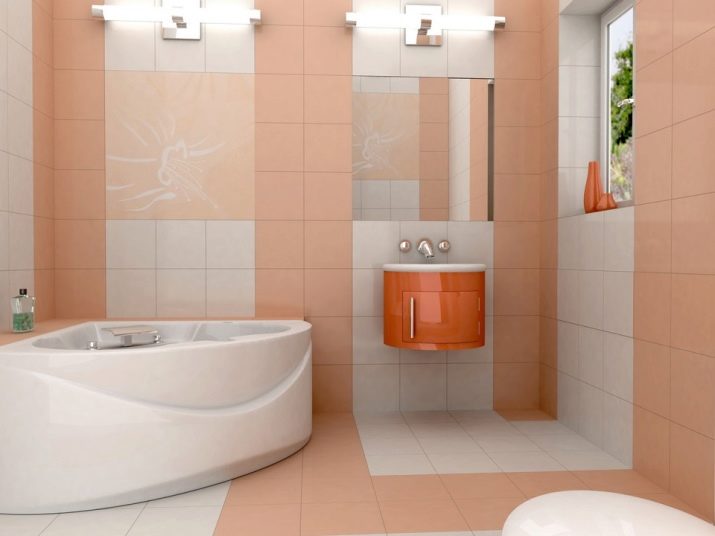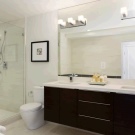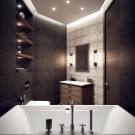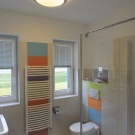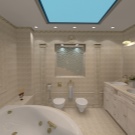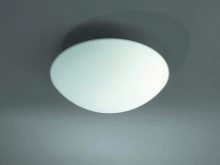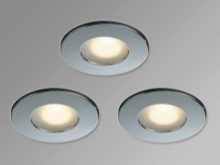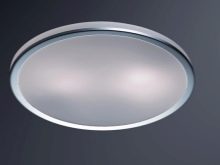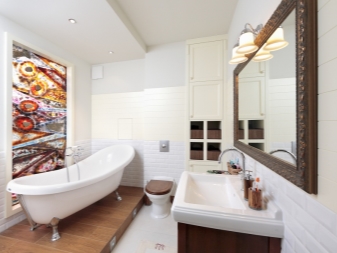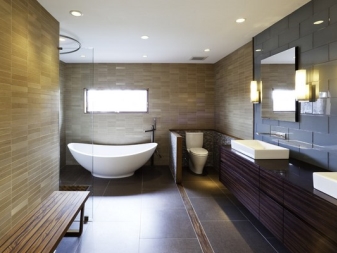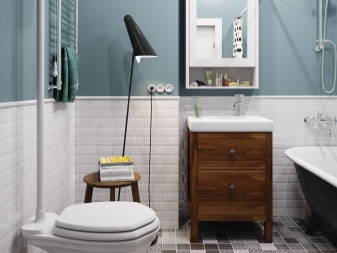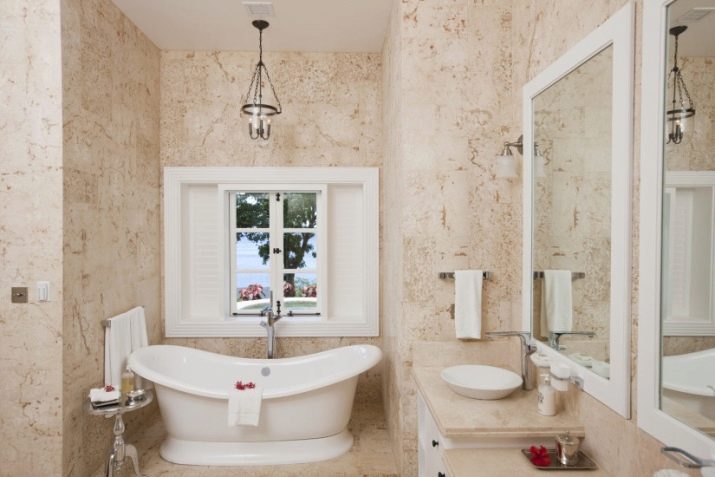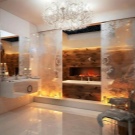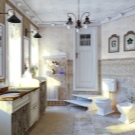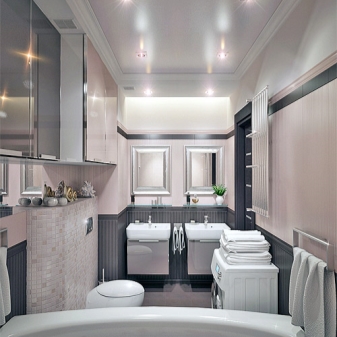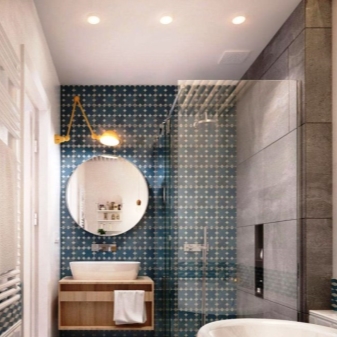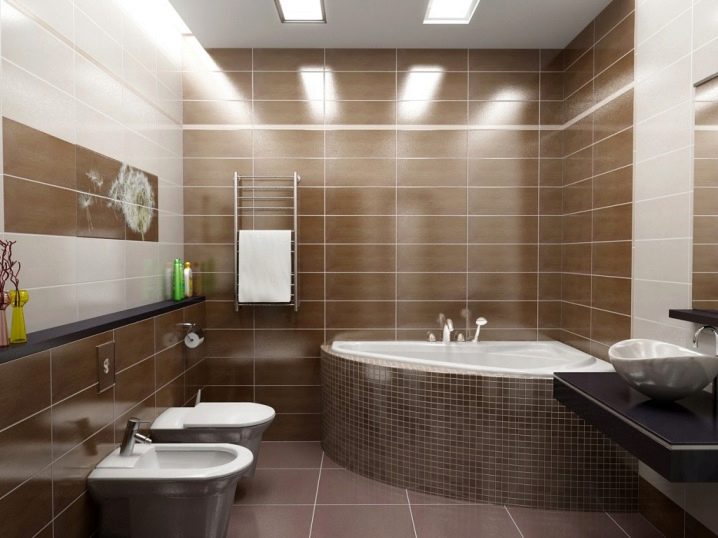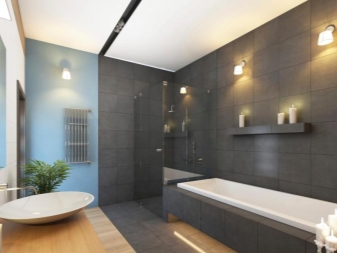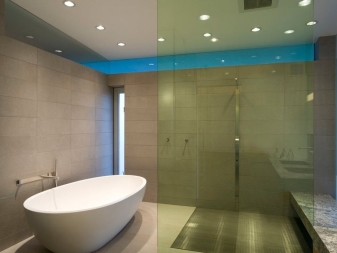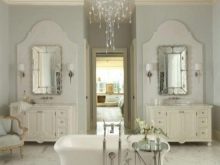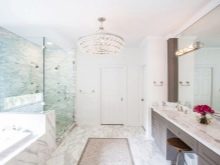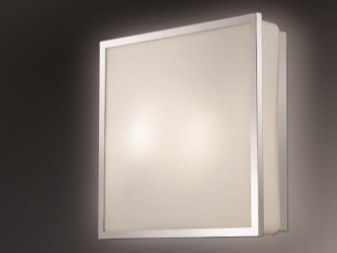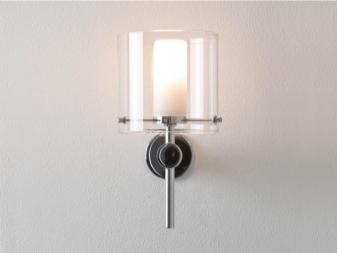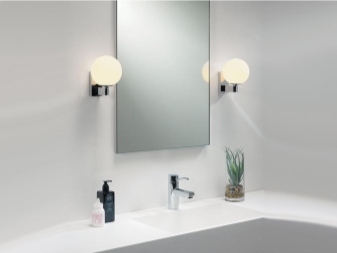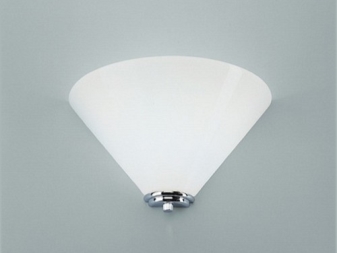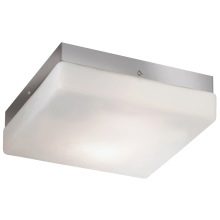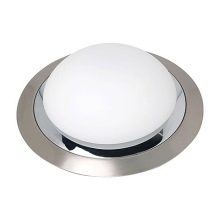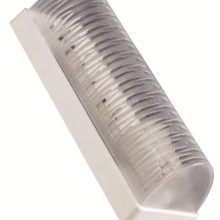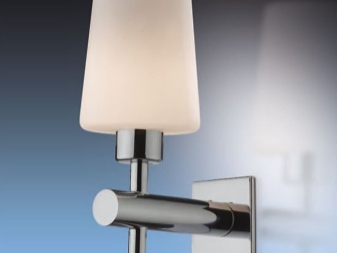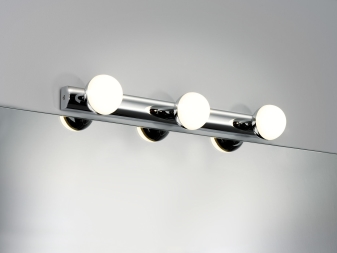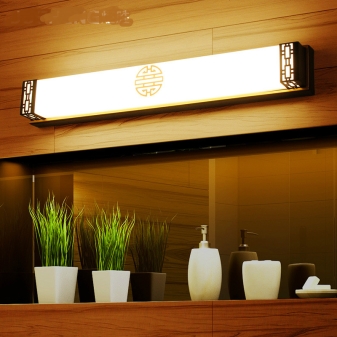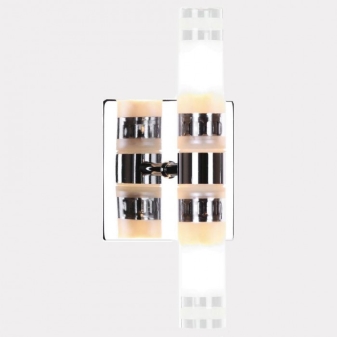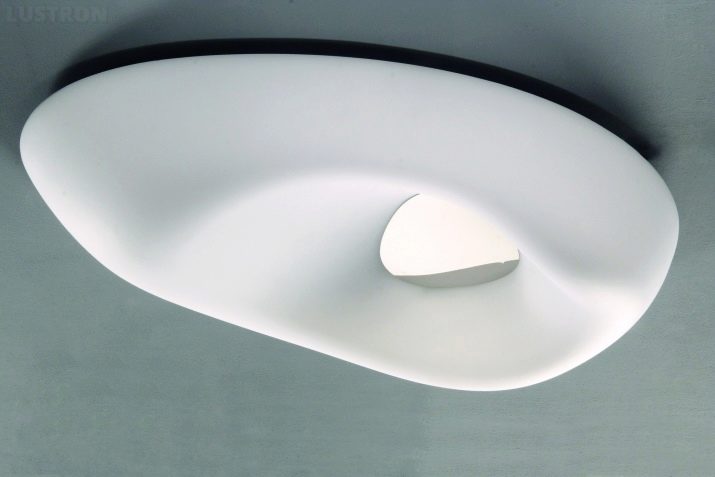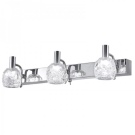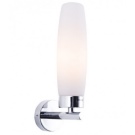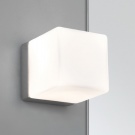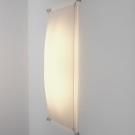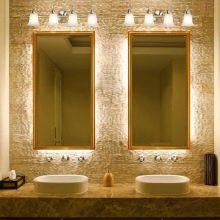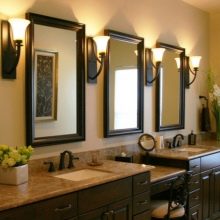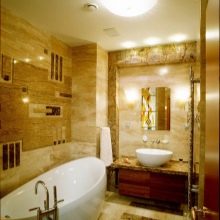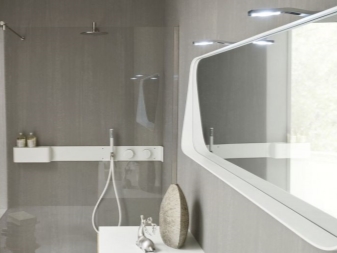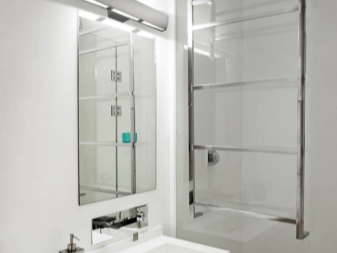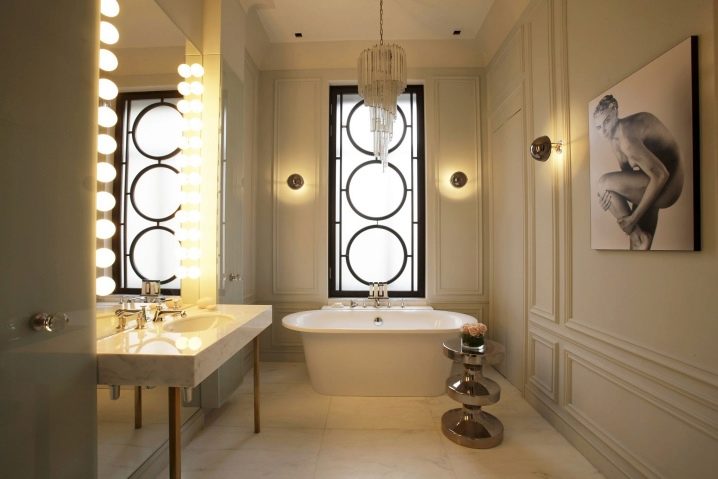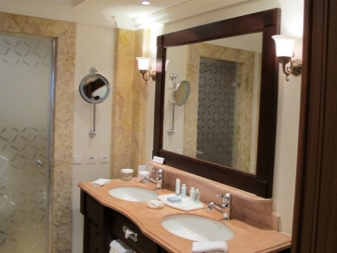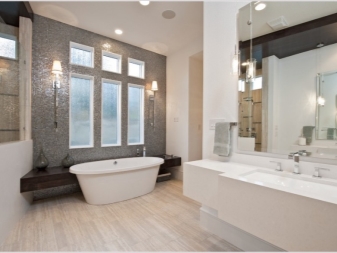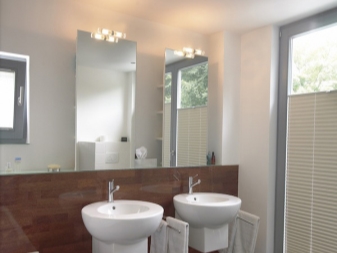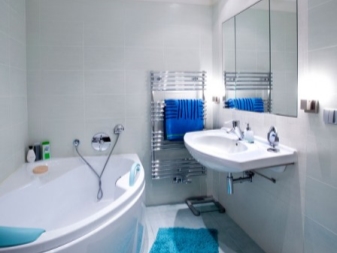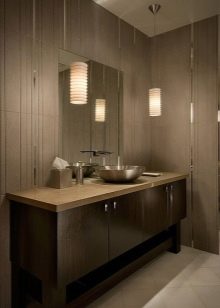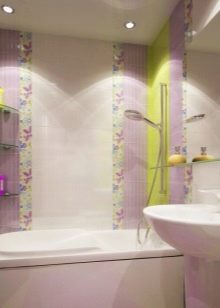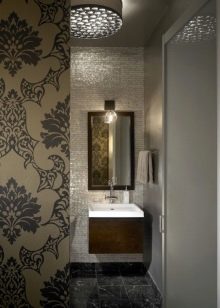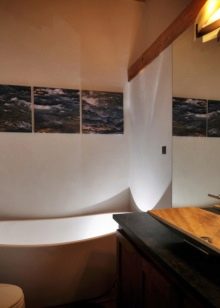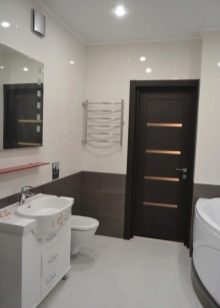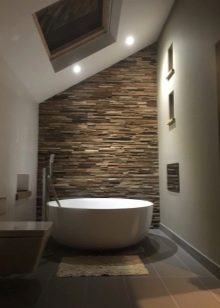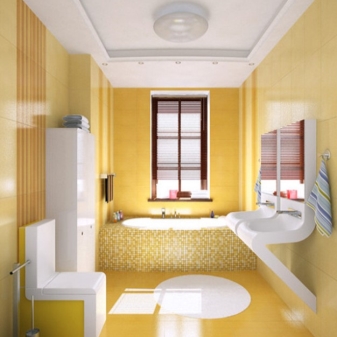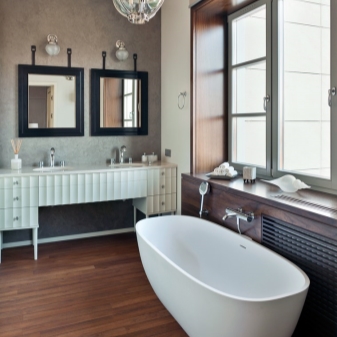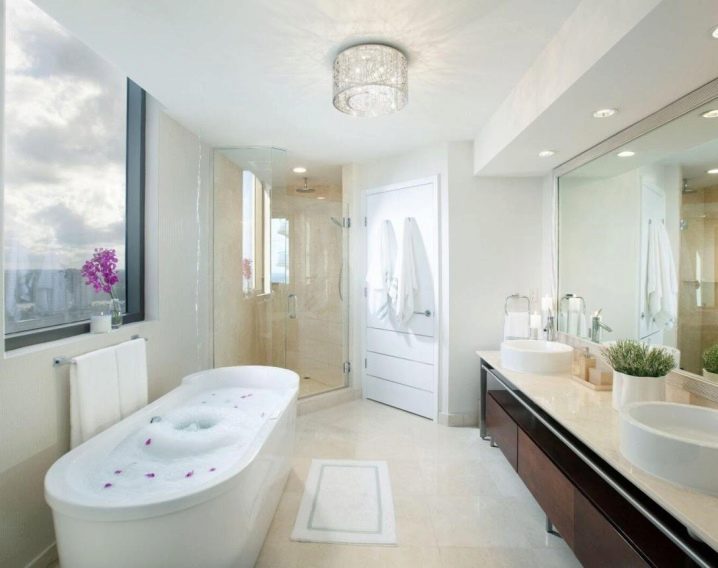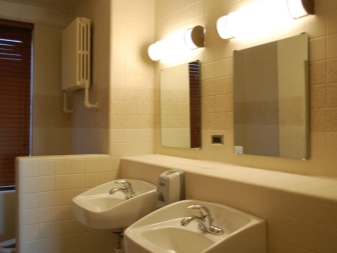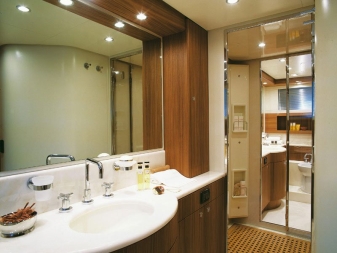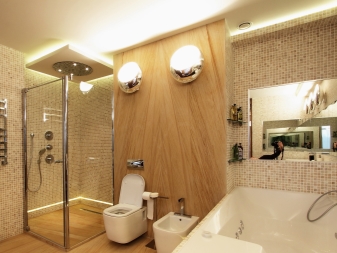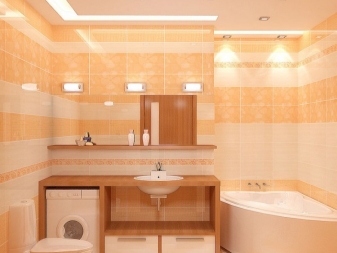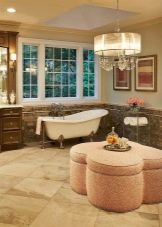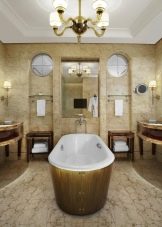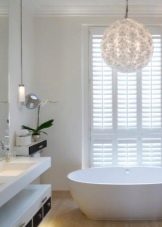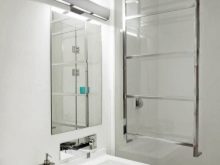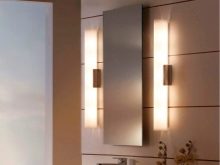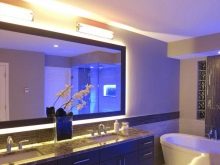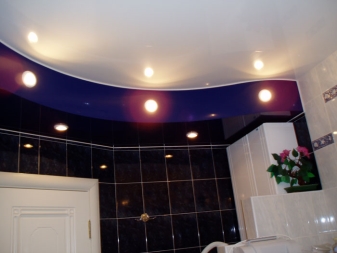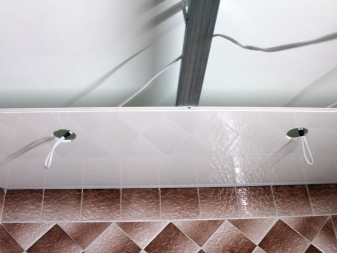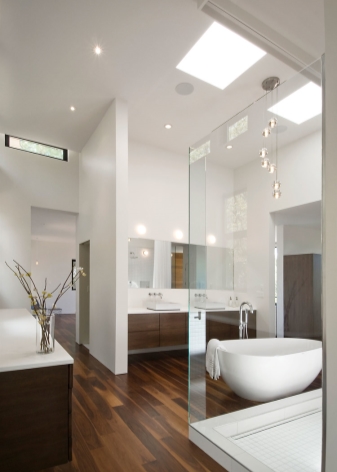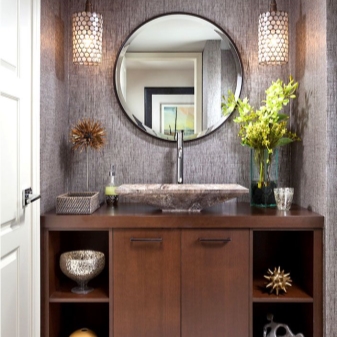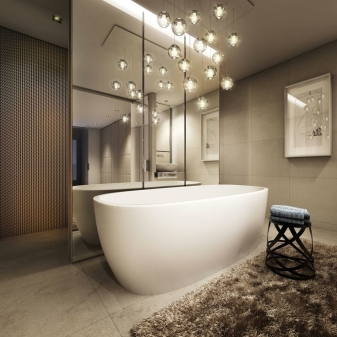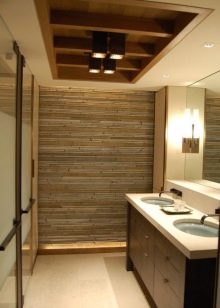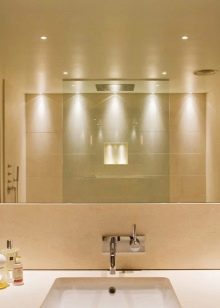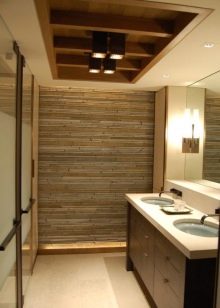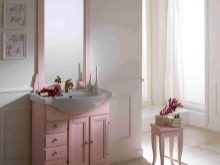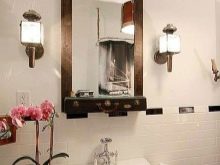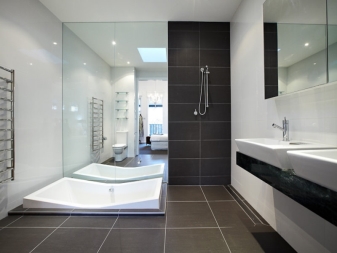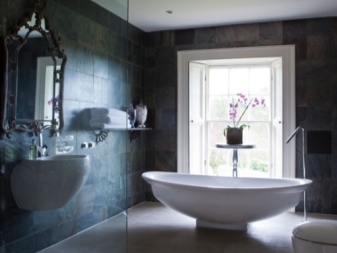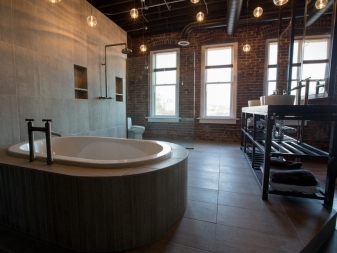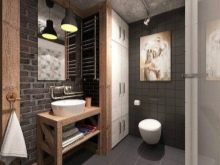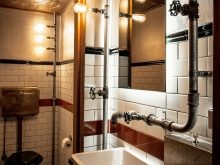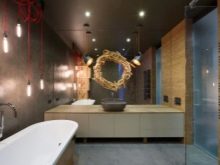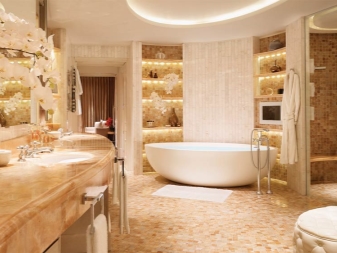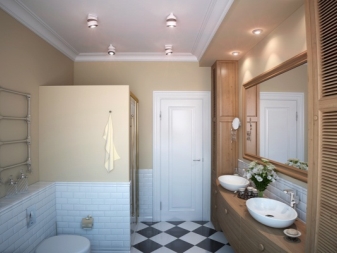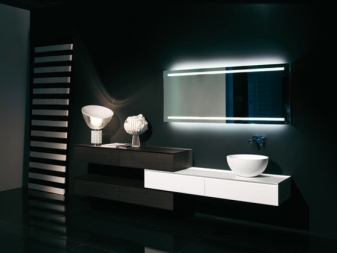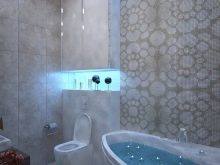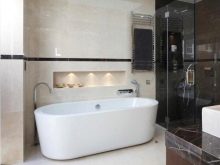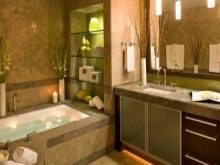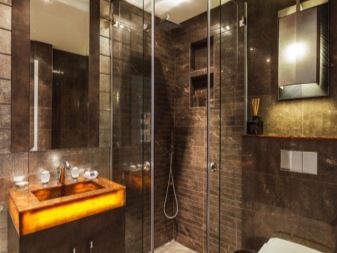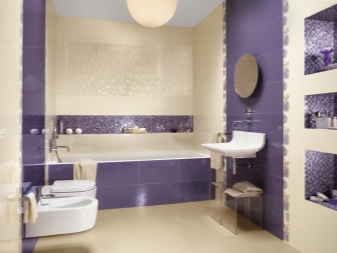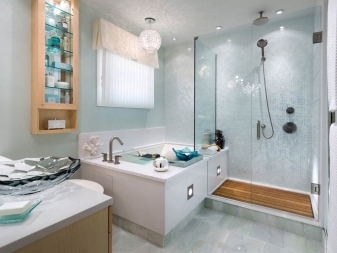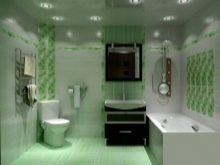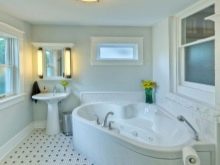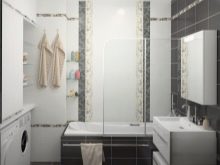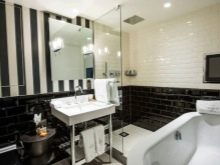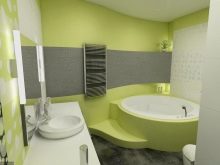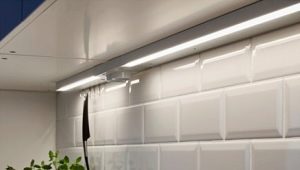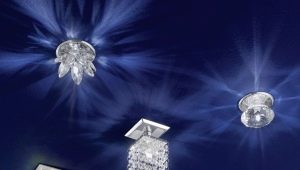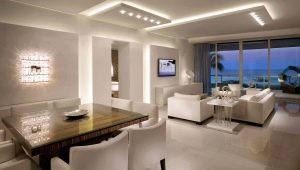Bathroom fixtures
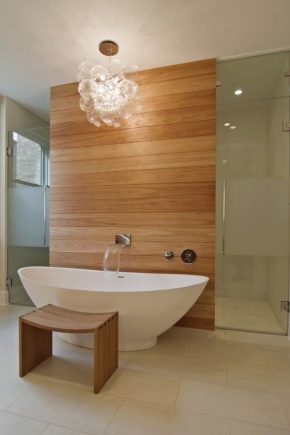
To choose lamps for the bathroom, you need to take into account the characteristics of the room, including the stylistic. Having understood all the variety of lampshades, it will become much easier to create a unique design of a bathroom and a toilet with the help of lighting. It is also necessary to calculate the required number of fixtures to create a sufficiently bright light.
Special features
When choosing lamps for the bathroom, one must take into account not only the characteristics of the lamps themselves, but also the room. Installing the right lighting in the bathroom is not so easy because of the high humidity and constant temperature drops.
When planning the wiring of light for the bathroom and toilet, you need to isolate well not only the lights themselves from the water, but also the wiring.
Relevant and the question of mold.Some materials from which chandeliers are made easily become infected with a fungus, and the result is an unattractive look. Therefore, an important indicator for bathroom fixtures is resistance to all sorts of similar troubles.
Since the installation of such systems requires considerable costs, it is important to install durable models that will not become unusable. Ideally, the lamp should last without replacement until the next repair. In addition, a quality model will not lose its attractive appearance.
In modern bathrooms it is customary to install not only the overhead light, but also local lighting.
A mirror is usually equipped with lighting elements, since it often plays the role of not only a mirror for washing, but also a make-up. It is worth remembering that within a radius of 60 cm from the sink there is an area most susceptible to splashing water, therefore, to install within these limits, it is necessary to select the most protected lighting devices.
The security of a particular luminaire model is indicated on its case by means of an IP index. This index shows how resistant the lamp is to penetration of dust or water.
Lamps with the following indices are suitable for installation in the bathroom:
-
Within the bath or shower, lamps should be installed with the highest IP65 index, which means that the model is protected from directed water jets.
-
Within 60 cm from the sink and 60 cm from the bath or shower is allowed to install lamps with a lower IP44, protected from water splashes.
-
In other places in the bathroom, a sufficient degree of protection is IP23. In such cases, the lamp is protected from dust and water vapor, but it will not withstand the effects of direct moisture on it.
You should not buy models of lamps for the bathroom without an IP indicator, since this often means that the products have not passed the mandatory certification.
Species
A different design of lamps is chosen for the bathroom, which is determined by the style and size of the room. Properly selected lighting device can completely transform the proportions of the room, making them more attractive and harmonious.
To date, ordinary dot embedded models in the form of "tablet" are in great demand. They are mounted in the ceiling, and for small bathrooms such samples are enough to create light.
More unusual look design samples that have a special configuration or colors. The design model can be invoice or built-in, however, it is worth noting that there are a lot more design options for invoice spot lighting.
There are also more familiar models, for example, a sconce with a socket and with a switch on the body itself. The use of luminaires with exposed wires is not approved, because in case of damage to the insulation a person can get a serious injury by current. For safety reasons, professional builders and designers recommend hiding all wiring in the walls or ceiling, leaving only one ceiling with a light bulb outside.
In large bathrooms in places where moisture does not fall, you can put a floor lamp. It will highlight particularly dark areas, creating the necessary level of brightness in the room.
Speaking of large bathrooms, one cannot fail to mention the trendy trend - the use of pendant chandeliers in the design. They can be on the rod for height adjustment, overhead or ordinary suspended. As a rule, this innovation is suitable only for modern interiors.The rooms, complemented by a hanging chandelier, are completely transformed. Such a functional room as a bathroom, immediately begins to give the impression of a cozy and regal corner.
Bathrooms use many different types of fixtures, and the choice of one or another option depends entirely on the creator of the interior.
Which is better?
Depending on whether you are looking for an option for a small bathroom or for a large one, different design ideas will do.
For a small room is best to opt for the built-in lighting. It is not necessary to select the overhead model or the more suspended, they only litter the already small room. Please note that with the help of built-in lamps you can visually balance the proportions of the room, make it bigger.
When choosing in favor of the built-in lighting should be especially careful about the manufacturer of the lamp. For the bathroom, you need to buy models of proven brands that have proven themselves in the market and provide a long warranty on their lamps.
Eminent companies have specialized lines for lighting bathrooms, and it is desirable to select such special samples.
Do not choose models without protection from moisture. In whatever, in your opinion, you would not place a lamp in a dry corner, the risk is still great that water will fall on it. At best, the lamp can simply fail, and at worst - short circuit the entire network. It is best to select models with solid shades of waterproof materials that do not let moisture inside.
If you select the backlight for the mirror, you must again build on the safety of the structure. In this case, in addition to tightness, lamps should not produce too bright light, beating in the eyes. Usually in bathrooms make tiled floors, on which it is easy to slip in the wrong lighting of the entire room.
Suspended chandeliers look harmoniously only in large bathrooms. When choosing a suitable model, pay attention to whether it is sufficiently resistant to the effects of hot water vapor.
Even models that are not installed directly above the bathtub or shower are exposed to high humidity, and it is important that the chandelier does not sparkle at the most inopportune moment.
Manufacturers Overview
Many countries produce decent models for bathrooms.Among them, European manufacturers enjoy a well-deserved honor. Italy, Spain, Belgium, Germany, Czech Republic care about their reputation by producing only high quality samples.
It is worth noting Italian chandeliers, which are different from all the others by a huge selection of design solutions. It can even be said that Italy is the trendsetter in the market for lamps.
Options are in great demand from Turkey. Turkish lamps are of high quality, modern and much lower than European ones. Turkey is among the leaders in the lighting market, as the quality of Turkish models is on a par with models from Europe, but the choice of various fashion options is less. In addition, most European manufacturers offer luxury models, while Turkey offers models for the middle class.
Russia produces much less quality models than Europe or Turkey, but prices are steadily keeping up with European ones. In Russia, there are not so many really worthy manufacturers providing tolerable options that have passed the mandatory certification.A small assortment also does not add popularity to Russian lamps.
The stereotype is that China producing low-end products, alas, does not always turn out to be just a stereotype. Cheap models are not of good quality, but they are presented in a wide range. Large selection - the only plus models from China. Do not fall for the low price bait, remember that the miser pays twice.
Best manufacturers:
-
Mantra (Spain);
-
B. lux (Spain);
-
AXO Light (Italy);
-
IDL (Italy);
-
Ozcan (Turkey);
-
SEDA (Turkey);
-
Fibo (Germany);
-
Schmitz-Leuchten (Germany).
How to choose?
First of all, you need to think about the security of bathroom space. It is necessary to buy high-quality fixtures from trusted manufacturers, the only way you can avoid many problems. For example, it is not always possible to immediately replace a burned-out lamp that was in use for only a couple of weeks: the repair budget is simply not designed for this. In order not to pay twice, buy a good quality model at once.
When buying, check whether the luminaire is compatible with your ceiling type. For example, not all light bulbs are suitable for mounting on tension sheets, as they are so heated during operation,that simply melt the surface of the ceiling. The deformed stained ceiling is not needed by anyone.
Check the IP index. Choose a value that is optimal for the zone where the lamp is located. This issue was discussed in more detail in the "Features" section.
Choosing a light bulb, it is best to give preference to LED options. Such models have the longest service life, which can be up to 50 hours. They do not heat up during work, moreover, there are various variations in light temperatures: from mild yellowish to cool white.
Do not be afraid to combine different types of lighting. Ideally, you should try to highlight all three zones: upper, middle and lower. Choosing a particular lamp, pay attention to how it is combined with other lighting devices and with the whole room as a whole.
Some aspects of the choice should be considered in more detail, since they often cause the greatest difficulties.
How much should it be?
Bright light in the bathroom is not always appropriate. Sometimes it is necessary to create a relaxing atmosphere, implying a subdued soft light.It is usually this effect that is achieved in SPA salons, and it is quite possible to reproduce this at home. The main thing is to remember how many lamps should be in the room and how much light each of them should give.
There is a standard level of illumination for each room. The total number of lamps varies depending on the area of the premises, as well as the required level of illumination. The table shows the detailed power in watts.
|
The area of the bathroom, square. m |
Bright light (about 500 lux) |
Medium light (about 300 lux) |
Soft light (about 150 lux) |
|
0-6 |
150 W |
100 watts |
60 W |
|
6-8 |
200 watts |
140 W |
80 W |
|
8-10 |
250 W |
175 watts |
100 watts |
|
10-12 |
300 watts |
210 W |
120 W |
|
12-16 |
400 watts |
280 watts |
160 watts |
|
16-20 |
500 watts |
350 W |
200 watts |
|
20-25 |
600 W |
420 watts |
240 watts |
|
25-30 |
700 W |
490 watts |
280 watts |
It must be remembered that each of the lamps differs in its level of light output, so it is important to focus on it when calculating the required number of lamps. You need the total power from the table divided by the power of the selected lamp, and you get the number of necessary fixtures.
Remember that these values are approximate and require adjustments in the course of work. In addition to the calculations, be guided by the purpose of the zone.Some of the spaces require more intense light than others, for example, the area of the mirror should be well lit, and the corner spaces should not be equipped with additional lamps.
Optimal size
A suitable dimension of the lamp is closely correlated with the shape and size of the bathroom itself. The height of the ceilings also matters, as the length of the luminaire directly depends on this.
For a small low It is desirable to choose flat built-in models that fit tightly to the ceiling. It can be spotlights with a diameter of 60x60 mm or wide flat overhead chandeliers of large diameter. For small rooms, spotlights are mainly selected, since they are sufficient for lighting and do not take up much space.
For small bathrooms with high ceiling You can use midsize, minimalist designs or small, intricate designs. In both cases, the lamp can not give enough light, so that it is complemented by small point models of high brightness.
For spacious rooms the choice of dimensions is large enough, but there is one limitation: the main lamp should not be small.Small models in large rooms look ridiculous, even if it is a bathroom. You can pick up the overhead chandelier of large diameter or suspended fantasy model. From small pendant lights, you can create a whole composition. It is advisable to additionally use small dot embedded LEDs.
For mirror illumination do not usually use large fixtures. Models are mounted around the perimeter of the mirror and do not exceed its dimensions. Often a long lamp is smaller than the sides of the mirror, no matter where it is fixed: above, below or on the sides.
Forms
The traditional form of ceiling lights is a circle. Round models fit most styles of interiors, as well as fit into all rooms, regardless of their size and proportions. At present, absolutely all bathroom fixtures are made round: spot, overhead, pendant.
Square options are more often used as wall lights. They are used as lighting for mirrors, niches, interesting details. Since square lamps look unusual and modern, they are often used as independent decorative elements - an alternative to paintings.Models in the shape of a square can be made in different dimensions, but one cannot meet the dotted embedded square models. This is due to the features and fragile design of the ceiling.
Figured options are used in large rooms bold stylistics. Lamps can be made in the form of crystals, balls. Popular options-spot with adjustable narrow stream of light.
Tubes are used to illuminate mirrors or other interesting elements in the bathroom. It is possible to fix a cylindrical version both horizontally and vertically. There are even interesting double models running in a two-lamp package. Models are made in a waterproof version, so that they can be installed in an area of high humidity, for example, close to the bath itself.
The choice in favor of this or that configuration is limited only by the imagination of the owner of the bathroom. It is important to take into account the functional purpose and location of the lamp in order to choose the variant of the most suitable form.
Materials
There are materials that are absolutely not designed for installation in places of high humidity. It includes wood, gypsum, ceramics.Despite the fact that many are not averse to installing a wooden lamp in the bathroom, it is strongly not recommended to do this.
Wood is a very “capricious” material that quickly loses its appearance due to sudden temperature changes, and in a room with high humidity, wood can even rot.
Plastic, on the contrary, is well acclimatized in bathrooms. Overhead structures made of plastic panels with LED filling have long become classics of the genre for decorating bathrooms.
Please note that only LED bulbs can be used with plastic shades, all other samples will cause the case to turn black and melt.
With the models in the case of glass, everything is just the opposite. Glass tolerates temperature changes and high humidity, today being the most preferred option for bathrooms. Both matte and transparent variations cope with their protective functions equally well, the difference is only in the softness of the light: in the first case the luminous flux is sharper, and in the second - diffused.
Often plastic or glass samples have metal, mostly aluminum, blotches. It is not susceptible to corrosion and weighs quite little, with the result that it has received wide recognition.In the design of bathrooms often use aluminum inserts in the color of chrome, bronze, light silver. These colors are the most versatile and are suitable for both classic and modern bathrooms.
Actual styles
Bathrooms are furnished in completely different styles, respectively, and lighting fixtures for them are selected different. Somewhere it is appropriate to use fancy pendant lamps, somewhere - a modest spotlight.
For bathrooms and toilets in retro style, it is typical to use fancy hanging structures.
Despite the fact that their light is sometimes not enough, the use of additional lighting is not welcome. The maximum that you can decide on is to attach a pair of wall sconces of classic design in the mirror zone or on the sides of the bath. Glass or crystal in combination with a metal forged base is chosen as the material for the chandelier.
Oddly enough, the hallmark of modern techno-bathroom interior is the lack of lighting. It uses all sorts of small models of lamps: point, ceiling and wall spots.Most often, it is customary to install only one type of luminaire, avoiding the creation of combinations.
A mandatory element is the presence of a mirror light. It is desirable for the design of the bathroom to choose a cold white light, the temperature of which is kept at about 4000 kelvins.
Popular loft direction opens up a wide scope for experimentation, as it approves the use of almost all types of lamps, ranging from classical chandeliers and ending with ultramodern long models. Their various combinations with each other for zoning a room are welcome, for example, lighting the sink and bath with one type of light, rug and wardrobe with towels - with another, and the like.
How to arrange?
To make the lighting as comfortable and functional as possible, the lighting should be placed at strategic points in the room. The greatest difficulty is the location of the lamps at the mirror. In this case, it is important to place the backlight either around the perimeter or on the sides of the mirror, because if you place the lamps on top and bottom, it will distort your reflection, making it difficult to correctly put on makeup or shave.
Do not forget to put an additional floor lamp next to the towel rack. This will make the bathroom more comfortable, at the same time making it easier to navigate when searching for the necessary item. If the cabinet is in the so-called “wet” zone, use a few spot spotlights or a suspended model of diffused light in a waterproof housing.
You can place the LED strip of regular light behind the sink at the faucet. This option will save you from having to turn on the overhead light if you only need to wash your hands. This will lead to large energy savings, freeing up the budget for more important purchases.
Create a highlight of niches or interesting details, arranging the light so that attention is paid to such elements. This will make the overall interior more interesting and dynamic.
Stylish options in the interior
- Overhead spotlights are often used in small bathrooms with high ceilings. Burnt models are easy to replace with new ones. The height of the ceiling makes it possible not to greatly influence the steam on the ceiling itself, thereby practically having no effect on the embedded wiring.
-
Here it is worth paying attention not so much to the ceiling lights and the wall model, as to the luminous sink. Such a solution is extremely unusual and will not fit into every interior, however, in the particular case cited, the luminous sink is the main focus of the whole room.
- Fully sealed round pendant chandelier creates soft diffused light. As a rule, one such lamp is enough to light a small bathroom. Most likely, in the dry corner of the shelves is another lamp, as the light from the chandelier is not enough to illuminate the entire intended area.
- Elite crystal models are usually not installed in bathrooms, but this example is special. Many unusual solutions are used here: a lambrequin on a window, a mirror ball on the edge of a jacuzzi, and so on. The lower zone is illuminated with lights built into the bath. Such a move made the room space more visually.
- In this case, the light is used metered and serves to create a special atmosphere. Soft candlelight in harmony with the illumination of the mirror zone.Spotlights, creating directed light streams, sufficiently illuminate the rest of the area. Using the built-in lighting directly in the bath makes the room interesting and modern.
- In low bathrooms, equipped with a stretch ceiling, it is best to use built-in spotlights. They will not take up much space, will not draw attention to themselves and will create a sufficient level of lighting in the room. It is advisable to equip the mirror with additional lights that do not allow water to pass through.
- Original lighting designs look interesting and in a good old-fashioned way. The designer picked up the perfect duo from the ceiling patch chandeliers and spectacular sconces. You may notice that there are two switches near the sink: for the ceiling light and for the sconce. It is better not to use the switches in this place, if water gets on them, a short circuit may occur.
- Several overhead ceiling lamps are a great alternative to recessed lighting. They look extremely harmonious, as the size and shape are almost identical to the tile, which is lined with walls and floors.Chandelier cover plates prevent water from directly entering the bulbs.
- Despite the retro patina, the bathroom is still modern thanks to the competent selection of mirror lights. The minimalistic design and use of high-end material made them an important part of the room. They are not protected from water, so the designers correctly separated them from splashes by the glass partition.
- In a room with niches a good solution would be to create their backlight. So the bathroom is completely transformed, there is an illusion of a large room, continuing and outside niches. It is also necessary to focus attention on details, for example, on objects hidden in niches or mirrors.
More examples of bathroom fixtures can be viewed in the video below.
